- April 2018
- March 2018
- February 2018
- January 2018
- December 2017
- November 2017
- October 2017
- September 2017
- August 2017
- July 2017
- June 2017
- May 2017
- April 2017
- March 2017
- February 2017
- January 2017
- 2017
- 2016
- 2015
- 2014
- 2013
News : August 2017
Special Cover on Rejuvenation of tanks and wells in Vijayapura - 18th August 2017.
Vijayapura (Bijapur) of Karnataka State set an exemplary move for combating drought and achieving self-sufficiency in water utilization by rejuvenating traditional water resources and employing traditional harvesting techniques. Taj Bavadi is a heritage well built in 1620 by Ibrahim Adil Shah in memory of his quees Taj Sultana. Among such heritage wells, locally known as Bavadies, Taj Bavadi occupies first place with its size and grandeur. Such 20 heritage wells were rejuvenated with the aid of local donors, special grant from the Water Resource Ministry of Govt. of Karnataka through City Corporation.
On the occasion of National Water Convention held at BLDE ground, Vijayapura (Bijapur), a Special Cover was released on Rejuvenation of tanks and wells in Vijayapura commemorating Taj Bavadi by Chief Ministerof Karnataka Sri. Siddaramaiah in presence of Postmaster General, NK Region, Smt. Veena Srinivas and other guests. (Special Cover Approval No. KTK/68/2017).


Commemorative Stamps on Beautiful India– 15th August 2017.
India Post has issued a set of two stamps and a miniature sheet on the theme Beautiful India on 15th August 2017.(Denomination Rs. 15 each). Stamp designs are based on paintings created by school children.
 |
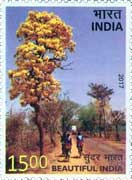 |
Commemorative Stamps on Caves of Meghalaya – 15th August 2017.
India Post has issued a set of 4 stamps and a miniature sheet on Caves of Meghalaya on 15th August 2017. The stamps depicts four caves Krem Blang, Krem Lymput, Krem Sydai and KremKhung.
Krem Blang: A cave near Shilong in Jaintia hills.
Krem Khung:The 20th edition of the International Cave Expedition under the project Caving in the Abode of the Clouds was able to explore a new cave known as Krem Khung in Larket of Jaintia Hills district. According to the Meghalaya Adventurers’ Association general secretary, Brian D. Kharpran Daly, the cave strewn with massive boulder blocks, has been explored and mapped to 5,120 metres.
Krem Lymput:Krem Lymput is found of the north jap state of Meghalaya. The cave is of Khasi hill vi metric linear unit far from the village of Nongiri. Meghalaya is understood for its rains and caves. Meghalaya is understood because the wettest place on earth and with 1300 caves scattered round the state it’s a land of caves too. Mawsynram is found of the Khasi hills of Meghalaya that is understood because the space receiving the heaviest downfall of the globe. erst Cherrapunchi was acknowledged for the significant downfall. however of recent times Mawsynram snatched the title away.
Krem Syndai:An obvious track down the slope from the village to a point where it steepens and immediately below this, a small path heads off through the forest to the left for some 50 m into a depression, where the cave entrance lies.
The cave entrance is of stooping height but once inside the passage immediately opens up into impressive proportions, of 25 m or more high and 30m wide. The cave contains some impressive calcite formations in the form of stalactites, stalagmites and a lot of flowstone, which are sadly blackened by the kerosene bamboo torches used by the local people. This prompted the British excursion (Brooks 1993b; Brooks & Smartl995) to nickname the cave as “Krem Sooty.” This cave is revered by Hindu saddhus, who come from as far as Nepal.
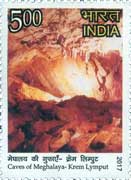 |
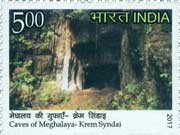 |
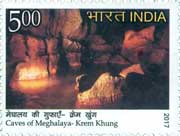 |
 |
Special Cover on Chaturmas Spiritual Function – 12th August 2018.
On the occasion of Chaturmas spiritual function of 9th Jain Acharya of Jaimal Gachchha and first Sravan Sanghiya Yuvacharya Pujya Mishrimal Ji Maharaj Sab “Madhukar”, a Special Cover was released on 12th August 2017 at Bhilai (C.G.). Dr. Sarita Singh, Chief Postmaster General, Chhattisgarh Circle released the special cover at a function held at Bhilai (C.G.). Dr. Pradip Jain, National Vice Chairman, Jainism Philately Group was instrumental in release of this special cover.
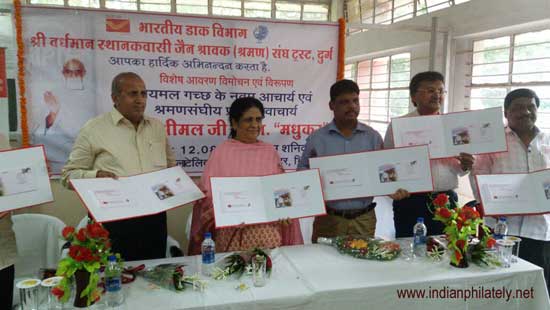
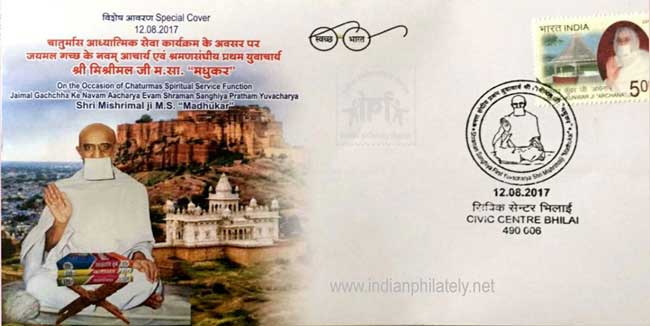
Courtesy: Sudhir Jain, Satna
Commemorative Stamps on 1942 Freedom Movement – 9th August 2017.
The Quit India Movement or the India August Movement, was a movement launched at the Bombay session of the All-India Congress Committee by Mahatma Gandhi on 8 August 1942, during, demanding an end to British Rule of India. The Cripps Mission had failed, and on 8 August 1942, Mahatma Gandhi made a call to Do or Die in his Quit India speech delivered in Bombay at the Gowalia Tank Maidan. The All-India Congress Committee launched a mass protest demanding what Gandhiji called "An Orderly British Withdrawal" from India. Even though it was wartime, the British were prepared to act. Almost the entire leadership of the INC was imprisoned without trial within hours of Gandhiji's speech. Most spent the rest of the war in prison and out of contact with the masses. The British had the support of the Viceroy's Council, of the All India Muslim League, the princely states, the Indian Imperial Police, the British Indian Army and the Indian Civil Service. The outside support came from the Americans, as President Franklin D. Roosevelt pressured PrimeMinister Winston Churchill to give in to some of the Indian demands. The Quit India campaign was effectively crushed. The British refused to grant immediate independence, saying it could happen only after the war had ended.
To commemorate 75 years of 1942 Quit India Movement a set of 8 Commemorative Stamps and a Miniature Sheet was released by The President of India, Shri Ram Nath Kovind at Rashtrapati Bhavan, in New Delhi on 9th August, 2017. The Vice President, Shri M. Hamid Ansari, the Prime Minister, Shri Narendra Modi and the Minister of State for Communications (Independent Charge) and Railways, Shri Manoj Sinha and Shri Ananta Narayan Nanda, Secretary, Department of Posts & Chairperson, Postal Services Board were also present on the occasion.
Set of 8 Stamps depicts Mahatma Gandhi drafting historical speech for All India Congress Committee meeting, Bombay 1942, Huge Crowd gathered outside the historic AICC meeting at Gowalia Tank Maidan, Mahatama Gandhi addressing the historic session of AICC at Gowalia Tank Maidan, Press report on the AICC meeting and the adoption of Quit Inda Resolution, Agakhan Palace where Mahatma Gandhi lost Mahadev Desai and Kasturba Gandhi, Mass uprising and demonstrations with women's participation in large numbers during the Quit India movement, Campaigners during the Quit India Movement, Demonstrators fearlessly confronting police during Quit India Movement.
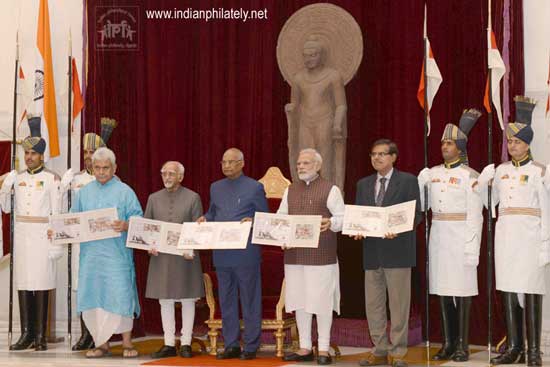
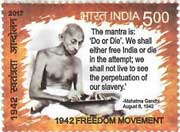 |
 |
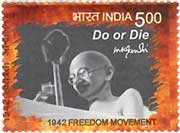 |
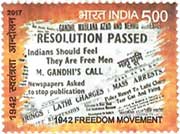 |
1942 Freedom Movement |
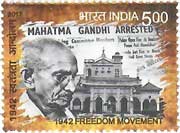 |
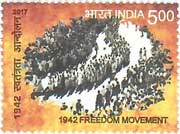 |
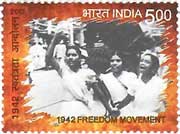 |
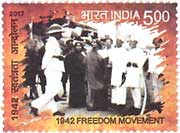 |
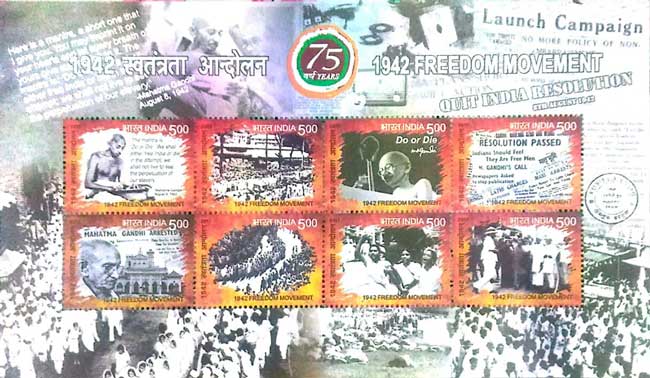
Special Cover on Celebration of 94 years of Khadhi Movement – 1st August 2017.
Khadi is a term used for fabrics that are hand-spun and handwoven, usually from cotton fiber. However, contrary to popular belief, khadi is also manufactured from silk and wool, known as khadi silk or woolen khadi respectively.
Khadi – the word conjures up images of Mahatma Gandhi and the Swadeshi movement he led. For a long time khadi was associated with the country’s freedom struggle and politics. During the Freedom struggle from British Rule, Mahatma Gandhi observed that, the poor weavers and farmers are getting poorer due to Indian markets flooded with British clothes resulting in Farmers forced to crops like Tobacco and opium and other crops which were more sought after by the British to fulfil the demands in their country. Cotton was a major crop besides the food grains and cotton was woven in small cottages to produce textile for clothing. That was the cottage industry and Indian economy at village level. Mahatma Gandhi started the Khadi Movement and encouraged spinning own cotton and using only Local Cotton (Khadi) as fabric for clothes.
A Special Cover was released on the occasion of Celebration of 94 years of Khadhi movement and 7 days stay (from 16th to 22nd April 1937) of Mahatma Gandhi to attend 3rd Annual Convention of Seva Sangh at Hudli Village, Belagavi Dist, Karnataka. (Special Cover Approval No. KTK/60/2017).

Courtesy: Suresh Rao, Bengaluru


